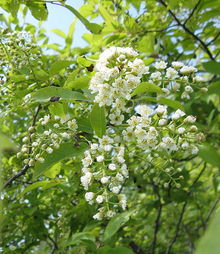With cold weather easing in many areas, horse owners often begin planting trees in areas where horses are kept. Unfortunately, some trees and plants are toxic to horses and steps should be taken to avoid having these trees near horses.

Chokecherry - toxic to horses
The danger of poisonous plants is that horse owners do not recognize them as posing any threat, and some of of the most common plants used in landscaping around around horse pastures and barns can be deadly.
Three of the most toxic trees for horses are the red maple, members of the cherry family including chokecherry, wild, black, and others, and oleander plants whether shrubs or trees.
Possibly the biggest danger of poisonous plants is that many horse owners do not recognize many of them as posing any threat to their horses. In fact, some of of the most common plants used in landscaping around homes and growing naturally around horse pastures and barns can be deadly to equines.
As horses become more suburbanized and move toward the city from the farm, suburban environments often include trees that are toxic to horses in landscaping and attractive windbreaks.
The red maple tree is common throughout the eastern United States as a native tree. It grows naturally in many places, and is also planted purposefully for landscaping purposes throughout the United States.
Red maple is a leaf that, when ingested in a certain amount causes significant breakdown of red blood cells and requires an extremely difficult, expensive treatment, which is most often unsuccessful. The usual situation involves horses eating the leaves from branches that blow off of a red maple tree during a storm or wilting leaves that fall from a tree in the pasture.
Clinical signs include weakness, depression, increased heart and respiratory rates, dark red urine, yellow colored mucus membranes, occurs one to three days following ingestion of leaves or bark. Break down of red blood cells is a cause of death. A number of horses throughout the US die from this problem each year.
Members of the cherry family including chokecherry, wild, black, and others, are trees or shrubs that usually have very showy flowers during the springtime, usually white or pink in color. Fruit is usually anywhere from red to purple in color when it is ripe.
Various varieties can be found throughout the United States. They can be found growing wild as well as being planted in landscapes. The leaves of these plants are the most toxic part. In some species the bark is also toxic.
Wild cherry was involved in one of the most equine toxic and costly situations in American history. It was involved with the Mare Reproduction Loss Syndrome in Lexington, Kentucky, where Eastern Tent Caterpillars were ingesting the leaves, concentrating the cyanide poison, and, in an unknown way contributed to the resorption and death of many equine fetuses in 2002.
These trees grew up as volunteers along the fence line and were occasionally present inside the pasture. Cyanide is the toxic principle and is a toxin that is required in very small amounts in order to cause damage. Wilted leaves may contain significant amounts of cyanide. The cyanide potential is greatest three to four days after branches have been cut or blown down. Dry leaves are not hazardous to horses.
Horses can show signs within an hour of eating wilted leaves. Clinical signs include severe respiratory distress, even sudden death. It behooves owners to walk pastures after storms to make sure red maples and/or wild cherry limbs have not blown into the pasture.pasture.
Oleander shrubs and trees are found throughout the United States where it is grown as an ornamental plant. It is also found along roadways and used for windbreaks.
The oleander has been used in landscaping around barns and between paddocks since the leaves are evergreen and the flowers are quite spectacular when the bush is in bloom. Ten leaves can kill a horse. Oleander contains toxins that affect the cardiac function of horses resulting in a fairly painful death within 2 to 3 days. There is no antidote for the toxin.
Making sure that you are aware of the toxicity of these trees assuring that they are not within oral contact with your horse, whether at your farm or at a horse show is important in preventing deaths of horses from these toxic trees.
Veterinarians and county extension agents are good sources of the names of other plants that are toxic to horses in a particular area. If you see them somewhere off your property where there are other horses, please pass on this information to that owner.
